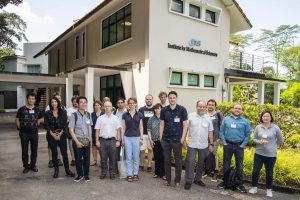Organizing Committee
Co-chairs
- Theodore A. Slaman (University of California, Berkeley)
- Yann Bugeaud (Université Strasbourg)
Members
- Verónica Becher (Universidad de Buenos Aires)
- Robert Tichy (Technische Universität Graz)
Contact Information
General Enquiries: ims(AT)nus.edu.sg
Scientific Aspects Enquiries: yann.bugeaud(AT)math.unistra.fr
Overview
This three-week program on equidistribution considers interactions between probability, number theory, computer science and mathematical logic.
An infinite sequence s(1), s(2), s(3), … of real numbers is equidistributed (also called uniformly distributed) modulo 1 if the sequence formed by the fractional parts of each term is equidistributed in the unit interval, which means that for each subinterval of the unit interval, asymptotically, the proportion of terms falling within that subinterval is equal to its length. For instance, any sequence of independent identically distributed (i.i.d) random real variables is equidistributed modulo 1. We do not know whether the sequence of integral powers of e (or pi, log 2, root 2, etc.) is equidistributed modulo 1.
To determine whether a given sequence of real numbers is equidistributed and, if this is the case, to estimate the speed of convergence to equidistribution (discrepancy) are usually difficult questions. Lacunary sequences are those where the ratio of successive terms is bounded away from one. A particular family consists of the sequences where the ratio of successive terms is a constant integer greater than 1. These are of the form (b^k x)_k where x is a real and b is an integer greater than 1. These sequences are equidistibuted modulo 1 exactly when every block of digits in the base b expansion of x occurs with the same asymptotic frequency as every other block of equal length. Emile Borel called these real numbers x normal to base b. We know no example of a familiar mathematical constant which is normal to some integer base.
One challenge is to prove the existence of real numbers enjoying simultaneously prescribed digital and Diophantine approximation properties, a more daunting challenge is to give explicit examples of such numbers. In between, one can try to give computable constructions of them.
An analog of equidistribution occurs when using Monte-Carlo simulation with pseudo random numbers, many problems remain to be studied from the point of view of number theory and computer science.
Activities
- General conference: 29 April–3 May 2019
- Focused talks: 6–10 May 2019
- Discussions and collaborations: 13–17 May 2019
Please note that our office will be closed on the following public holiday.
– 1 May 2019, Labour Day


